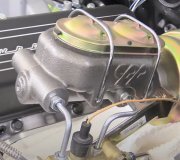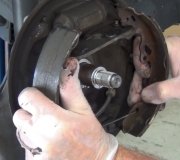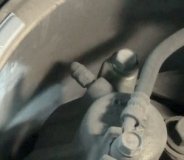The directions are here I just kind of need help following them and where im actually pouring the seafoam:
________________________________________________________________
Get the engine warmed up to operating temperature. While the engine is running, disconnect any main manifold vacuum line that feeds ALL the cylinders. For most cars, the brake booster hose works great. If you DON’T know which hose to use, post up on the forums to get an answer. Make sure you don’t pass Seafoam through the check valve – You’ll want to bypass the check valve, which, on many Nissans is located in the middle of the brake booster hose, up against the firewall. Disconnect the hose so that the check valve remains on the hose that goes TO the brake booster – Using the brake booster hose that goes towards the manifold, and insert a length of smaller hose into it, so that you get a tight seal. Now, some will say to pour the Seafoam into the hose. I don’t like this method, because you can spill it, you can dump in too much at once, or you can lose track of how much has gone in.
I prefer to dip the end of the hose into the can like a straw – Pretend you’re “sipping” the Seafoam out of the can. You’ll know you’re doing it right if the engine stumbles a little on each sip. Tell your assistant to keep the engine running, but not to give it TOO much throttle. Stay at or under 2,000 rpm’s. Don’t let it “chug” the Seafoam – Remember, small sips. You should be 1/3 to 1/2 of the way through the can in the first minute or so. You’ll see small amounts of white smoke from the tailpipe – Don’t be tempted to rev it hard – We’ll get to the REAL smoke show in a minute!
When you get almost halfway through the can, dunk the hose into the can, give it a good “chug” and let it stall the engine (or have your assistant shut off the engine immediately). I like to give the “3...2...1...” Countdown to time it *just* right. This will leave a good, wet dose of Seafoam on the cylinder tops and valves, where it can soak into and dissolve the varnish deposits that hold the carbon together. Let the engine sit for 30 minutes. While it’s sitting, dump the rest of the can into the fuel tank (use a funnel).
Now, restart the engine and go for a drive, someplace where you can drive the car hard. Make sure your windows are rolled up, you don’t want to stink up your interior. You don’t need to go far, and there’s no need to go getting a ticket, but I like to find a road where you can do a couple good 0 – to – 60 pulls at wide-open throttle without getting into a lot of traffic. You’re going to dump a TON of smoke, so there’s another reason I like to do my Seafoam treatment at night. Drive 5-10 miles and park the car. Let it cool down. The next time you drive, you’ll notice some residual smoking, and it’s gonna stink – don’t panic, you’ve got a lot of crap burning off. It’ll go away.
OK, you’ve got another can of Seafoam, right? Good. This can is going to be used to clean oil rings and lifters, clean built-up oil residues and contamination from the crank case, and clean the PCV system. You’re going to use 1.5 oz per quart of oil. Check your owners manual (or, again, ask on the forum). If you have a 5-qt oil capacity, you’ll be using 7.5 oz of Seafoam (roughly half a can). While the company claims you can leave the Seafoam treatment in your crankcase until your next oil change, I’ve found that most engines with higher miles have a LOT of nasty buildup, which can really take a toll on your oil filter. Therefore, I like to do an oil change roughly 50 – 100 miles after adding Seafoam.
The other half of the can? Add it to the crankcase after you change the oil if you had a lot of sludgy buildup, OR dump it in your fuel tank at your next fill-up. Seafoam is safe to leave in the crankcase with clean oil until your next oil change, and it’s also a great product to clean your injectors and fuel system.
SPONSORED LINKS
Thursday, June 7th, 2012 AT 5:50 PM



